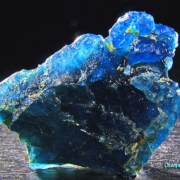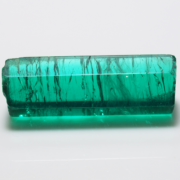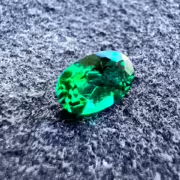Emerald: Geological Formation and the Role of Trace Elements in Color
Emeralds are one of the most sought-after and valuable gemstones, known for their vibrant green color and historical significance. They are a variety of the mineral beryl, characterized by a rich green hue due to the presence of trace elements. As a member of the beryl family, emeralds share the same basic chemical formula, Be3_33Al2_22(SiO3_33)6_66, with other beryl gemstones such as aquamarine and morganite, but they are distinguished by their distinct color and specific trace elements.

Emeralds are composed of beryllium aluminum silicate and owe their distinctive green color to trace amounts of chromium and vanadium. The color can range from a deep, intense green to a lighter, more yellowish or bluish green, depending on the concentration and combination of these trace elements. The most desirable emeralds are those with a vivid, even color and high transparency.
Chemical Composition:
- Base Mineral: Beryl (Be3_33Al2_22(SiO3_33)6_66)
- Trace Elements: Chromium (Cr) and Vanadium (V)
These trace elements replace aluminum in the beryl crystal structure, causing distortions in the crystal lattice and resulting in the absorption of certain wavelengths of light, which gives emeralds their characteristic green color.
Importance and Historical Significance
Emeralds have been treasured for thousands of years, with evidence of their use dating back to ancient civilizations. They were mined in Egypt as early as 1500 BCE, and Cleopatra, the famed Egyptian queen, was known for her love of emeralds, often wearing them as symbols of her wealth and power.
Historical Significance:
- Egypt: The earliest emerald mines were located in Egypt, known as “Cleopatra’s Mines,” where emeralds were used in jewelry and amulets and believed to have protective powers.
- Mesoamerica: The Incas and Aztecs valued emeralds, considering them sacred stones. They were used in religious ceremonies and as offerings to gods.
- Europe: In the Middle Ages, emeralds symbolized fertility and rebirth and were believed to have healing properties.
Cultural Importance:
Emeralds have been associated with various symbolic meanings and properties throughout history. They are often linked to fertility, rebirth, and love. In some cultures, emeralds are believed to have healing properties, enhance intuition, and promote truth and wisdom. As the birthstone for May, emeralds are also associated with spring and renewal.
The allure of emeralds has persisted through time, making them a favored choice for royalty and collectors. Their captivating color, combined with their rarity and historical associations, contributes to their enduring significance and value in the gemstone market.
In summary, emeralds are not only prized for their beauty but also for their rich historical and cultural significance. Their unique color, influenced by trace elements like chromium and vanadium, sets them apart from other gemstones and has captivated human fascination for millennia.
Contents
- Geological Formation of Emeralds
- Geological Environments
- Formation Process
- Locations of Major Deposits
- Crystal Structure of Emeralds
- Basic Crystal Chemistry
- Role of Chromium and Vanadium
- Role of Trace Elements in Color
- Chromium (Cr)
- Vanadium (V)
- Iron (Fe)
- Interaction and Balance
- Regional Variations
- Optical Properties of Emeralds
- Color Variations
- Pleochroism
- Conclusion
Geological Formation of Emeralds

Geological Environments
Emeralds form under specific geological conditions and are typically found in metamorphic and igneous rocks. The formation of emeralds is a result of the right combination of host rocks, tectonic activities, and the presence of beryllium and trace elements like chromium and vanadium.
Types of Host Rocks
- Schists
- Characteristics: Schists are metamorphic rocks characterized by their foliated structure, which results from the alignment of mineral grains under heat and pressure. They are rich in minerals like quartz, mica, and feldspar.
- Emerald Formation: In schists, emeralds form when beryllium-bearing fluids interact with chromium or vanadium-rich schist during regional metamorphism. The schists provide a suitable environment for emerald growth due to their permeability and the presence of necessary elements.
- Pegmatites
- Characteristics: Pegmatites are coarse-grained igneous rocks formed during the final stages of magma crystallization. They often contain rare minerals and elements.
- Emerald Formation: Emeralds can form in pegmatites when beryllium-rich fluids from the cooling magma interact with chromium or vanadium-bearing rocks. The large crystal sizes in pegmatites can lead to the formation of sizeable emerald crystals.
- Carbonaceous Limestone
- Characteristics: Carbonaceous limestone is a sedimentary rock composed primarily of calcium carbonate, with organic carbon content.
- Emerald Formation: In these rocks, emerald formation occurs when hydrothermal fluids rich in beryllium interact with limestone, which contains chromium or vanadium impurities. The organic material in carbonaceous limestone can play a role in reducing the oxidation state of chromium and vanadium, enhancing emerald coloration.
Tectonic Settings Conducive to Emerald Formation
 Tectonic Settings
Tectonic Settings
Emeralds are often associated with specific tectonic settings that facilitate their formation through the interaction of tectonic activity, heat, and fluid movement.
- Convergent Plate Boundaries
- At convergent boundaries, the collision of tectonic plates creates the necessary pressure and temperature conditions for emerald formation. Subduction zones, where one plate moves under another, can generate hydrothermal fluids that transport beryllium and other trace elements.
- Orogenic Belts
- Orogenic belts, or mountain-building regions, provide a favorable environment for emerald formation due to the intense metamorphism and fluid activity. These regions often contain the required host rocks, such as schists and pegmatites, where emeralds can crystallize.
- Rift Zones
- In rift zones, where tectonic plates are moving apart, magma can rise to the surface, bringing beryllium-rich fluids into contact with chromium or vanadium-bearing rocks. This interaction can lead to emerald formation, particularly in pegmatite-hosted deposits.
Formation Process
The formation of emeralds involves complex geological processes, including the movement of hydrothermal fluids and the precise pressure and temperature conditions.
 Hydrothermal Vent Diagram
Hydrothermal Vent Diagram
Hydrothermal Fluid Activities
Emeralds are typically formed through hydrothermal processes, where hot, mineral-rich fluids circulate through rocks. These fluids are often derived from magma or deep-seated metamorphic processes and carry beryllium and other necessary elements for emerald formation.
- Fluid Composition: Hydrothermal fluids are enriched with beryllium, silica, and trace elements like chromium and vanadium. The composition of these fluids is critical for the crystallization of emeralds.
- Fluid Pathways: Fractures, faults, and porous zones in host rocks provide pathways for the movement of hydrothermal fluids. These pathways facilitate the interaction between beryllium-bearing fluids and chromium or vanadium-rich rocks.
Pressure and Temperature Conditions
Emerald formation requires specific pressure and temperature conditions, typically found in metamorphic and igneous environments.
- Temperature Range: Emeralds form at temperatures between 400°C and 700°C (750°F to 1300°F). These conditions are conducive to the stability of beryl and the incorporation of chromium and vanadium into the crystal structure.
- Pressure Conditions: Moderate pressure is necessary for emerald formation, as it influences the solubility of beryllium and other elements in hydrothermal fluids. The precise pressure conditions vary depending on the tectonic setting and host rock type.
Locations of Major Deposits
Emerald deposits are found in several regions worldwide, each with distinct geological characteristics that contribute to emerald formation.

Overview of Global Deposits
- Colombia
- Location: Colombia is renowned for producing some of the finest emeralds in the world, particularly in the regions of Boyacá and Cundinamarca.
- Geological Characteristics: Colombian emeralds are primarily hosted in black shales and carbonaceous limestones, formed through hydrothermal processes. The presence of fault zones and the interaction between beryllium-bearing fluids and chromium-rich shales are key to emerald formation.
- Zambia
- Location: The Kafubu area in Zambia is one of the largest producers of emeralds globally.
- Geological Characteristics: Zambian emeralds are hosted in mica schists and talc-magnetite schists within the Lufilian Belt. The emeralds form through the interaction of beryllium-rich fluids with chromium-bearing rocks, under conditions of regional metamorphism and hydrothermal activity.
- Brazil
- Location: Brazil is a significant emerald producer, with deposits located in the states of Minas Gerais, Bahia, and Goiás.
- Geological Characteristics: Brazilian emeralds are found in pegmatites and schists, often associated with granitic intrusions. The emerald formation is driven by the interaction of beryllium-bearing pegmatitic fluids with chromium or vanadium-rich host rocks.
- Other Notable Deposits
- Russia (Ural Mountains): Emeralds in Russia are found in mica schists and phlogopite-talc schists, associated with hydrothermal processes and regional metamorphism.
- Pakistan (Swat Valley): Pakistani emeralds are hosted in talc-carbonate schists, with emerald formation linked to hydrothermal activity and regional tectonics.
Each of these locations has unique geological conditions that influence the color, clarity, and size of the emeralds produced. The combination of hydrothermal activity, tectonic settings, and the presence of essential elements like beryllium, chromium, and vanadium determines the quality and characteristics of emeralds from these regions.
Crystal Structure of Emeralds
 Emerald | Molecular structure
Emerald | Molecular structure
Emeralds are a variety of the mineral beryl, which has a distinct crystal structure that plays a crucial role in determining their physical and optical properties. The presence of trace elements such as chromium and vanadium is essential for the emerald’s characteristic green color.
Basic Crystal Chemistry
Beryl has a hexagonal crystal system with a highly symmetrical structure. The fundamental unit of beryl’s crystal structure is a framework of linked silicate (SiO3_33) rings, which create hexagonal channels along the c-axis of the crystal. These channels are aligned parallel to the c-axis and provide pathways that can host various elements or molecules.
- Crystal System: Hexagonal
- Space Group: P6/mccP6/mccP6/mcc
Key Structural Features:
- Silicate Rings: The beryl crystal structure consists of rings of six silicate tetrahedra (SiO4_44), each sharing oxygen atoms. These rings stack along the c-axis and form a tubular channel that runs the length of the crystal.
- Be and Al Sites: Beryllium (Be) atoms occupy tetrahedral sites within the silicate framework, while aluminum (Al) atoms are located in octahedral sites. The combination of these tetrahedral and octahedral sites stabilizes the beryl structure.
- Channel Sites: The open channels in the beryl structure can incorporate small ions or molecules, which can influence the physical properties of the mineral.
Chemical Formula: Be3_33Al2_22(SiO3_33)6_66
The chemical formula for beryl, Be3_33Al2_22(SiO3_33)6_66, reflects its composition and the arrangement of atoms within its crystal lattice:
- Be3_33: Three beryllium atoms in tetrahedral coordination with oxygen.
- Al2_22: Two aluminum atoms in octahedral coordination.
- (SiO3_33)6_66: Six silicate groups forming the ring structure.
Role of Chromium and Vanadium
The distinctive green color of emeralds is due to the substitution of trace elements, primarily chromium and vanadium, within the beryl crystal lattice.
Substitution in the Crystal Lattice
- Chromium (Cr3+^3+3+): Chromium substitutes for aluminum in the octahedral sites within the beryl structure. This substitution occurs because the ionic radius and charge of Cr3+^3+3+ are similar to those of Al3+^3+3+, allowing for a stable replacement.
- Vanadium (V3+^3+3+): Vanadium can also substitute for aluminum in the octahedral sites, though it is less common than chromium. Like chromium, vanadium’s ionic radius and charge make it suitable for substitution in the beryl lattice.
Effects on Crystal Stability and Growth
- Coloration: The substitution of Cr3+^3+3+ and V3+^3+3+ in the beryl lattice causes distortions in the crystal structure, which affect the way light interacts with the crystal. These distortions lead to the absorption of specific wavelengths of light, resulting in the characteristic green color of emeralds. Chromium typically produces a more intense green color, while vanadium can add a bluish tint.
- Crystal Stability: The presence of chromium and vanadium can influence the stability and growth patterns of emerald crystals. These elements can create local distortions in the crystal lattice, which may affect the clarity and quality of the emerald. However, their overall impact on the stability of the beryl structure is minimal due to their similar ionic properties to aluminum.
- Growth Environment: The incorporation of trace elements like chromium and vanadium requires specific geological conditions, including the availability of these elements and the presence of hydrothermal fluids that facilitate their movement into the crystal lattice during growth.
In summary, the crystal structure of emeralds is based on the hexagonal framework of beryl, with silicate rings and channels that host beryllium and aluminum. The substitution of chromium and vanadium for aluminum in the crystal lattice is crucial for the color and characteristics of emeralds, affecting both their appearance and growth conditions. These trace elements contribute to the emerald’s distinctive green hue while maintaining the stability of the crystal structure.
Role of Trace Elements in Color

Chromium (Cr)
- Chemical Role: Chromium is the most significant trace element responsible for the green color in emeralds. It substitutes for aluminum in the octahedral sites of the beryl structure. The ionic radius of chromium (Cr3+^3+3+) is close to that of aluminum (Al3+^3+3+), making this substitution energetically favorable.
- Optical Effects: Chromium causes the absorption of specific wavelengths of light. It absorbs light in the yellow and blue portions of the visible spectrum, while reflecting green light. This selective absorption is due to electron transitions within the chromium ions, known as ligand field transitions, which result in the characteristic deep green color of emeralds.
- Intensity and Hue: The concentration of chromium affects both the intensity and hue of the green color. Higher concentrations of chromium typically result in a more intense and vivid green, which is highly prized in the gemstone market. The specific hue can vary slightly, giving each emerald its unique appearance.
Vanadium (V)
- Chemical Role: Vanadium can also substitute for aluminum in the beryl crystal lattice, although it is less common than chromium. The ionic properties of vanadium (V3+^3+3+) allow it to replace aluminum without significantly disrupting the crystal structure.
- Optical Effects: Like chromium, vanadium contributes to the green color through absorption of light in specific parts of the visible spectrum. Vanadium can absorb light differently than chromium, often adding a bluish tint to the green color of the emerald.
- Influence on Color: While chromium is the dominant colorant in most emeralds, vanadium can enhance or modify the hue, especially in regions where vanadium is more prevalent in the geological environment. Vanadium-rich emeralds might exhibit a different shade of green, sometimes described as more bluish or lighter compared to those colored primarily by chromium.
Iron (Fe)
- Chemical Role: Although iron is not a primary contributor to the classic emerald green color, it can be present as a trace element in some emerald deposits.
- Optical Effects: Iron can influence the transparency and saturation of the green color. Higher levels of iron can cause a duller or more muted green, as iron tends to absorb light differently than chromium or vanadium.
- Impact on Quality: The presence of iron is often considered less desirable for high-quality emeralds, as it can detract from the vividness and purity of the green color. However, some emeralds, particularly those from certain geographical locations, may contain a balance of trace elements that create a unique and attractive color.
Interaction and Balance
The interaction between these trace elements is critical for determining the final color and quality of an emerald. The specific geological environment where an emerald forms influences the availability and incorporation of these elements into the crystal structure. Factors such as temperature, pressure, and the chemistry of the hydrothermal fluids involved in emerald formation can affect which trace elements are present and how they impact the color.
Regional Variations
Different emerald-producing regions have characteristic trace element profiles that influence the typical colors of emeralds from those locations:
- Colombian Emeralds: Typically have higher chromium content, resulting in a bright and intense green color. The lower levels of iron contribute to their high transparency and vividness.
 Colombian Emeralds
Colombian Emeralds
- Zambian Emeralds: Often contain both chromium and vanadium, sometimes with higher iron content, resulting in a slightly bluish-green hue with varying saturation.
 Zambian Emeralds
Zambian Emeralds
- Brazilian Emeralds: Can vary widely in trace element composition but often have a balance of chromium and vanadium, leading to diverse shades of green.
 Brazilian Emeralds
Brazilian Emeralds
In summary, the trace elements chromium, vanadium, and iron play a significant role in defining the color and quality of emeralds. Chromium is the primary contributor to the emerald’s rich green color, while vanadium can enhance or modify the hue. Iron, although less desirable, can influence the overall appearance and quality of the gemstone. The specific combination and concentration of these trace elements, along with regional geological conditions, determine the unique color characteristics of emeralds from different parts of the world.
Optical Properties of Emeralds
Emeralds are renowned for their striking green color, which is influenced by various optical properties. Understanding these properties, including color variations and pleochroism, is essential for evaluating emeralds and their quality.

Color Variations
Explanation of Why Color Varies
Emerald color variations arise from several factors, including the concentration and distribution of trace elements, as well as the presence of inclusions and structural imperfections.
- Trace Element Concentration and Distribution
- Chromium (Cr): The primary colorant in emeralds, chromium imparts a rich green hue. Variations in chromium concentration can lead to differences in color intensity. Higher chromium levels generally produce a more vivid and saturated green, while lower levels result in a paler hue.
- Vanadium (V): When present, vanadium can influence the color by adding a bluish tint to the green. The amount of vanadium relative to chromium can alter the overall shade of green, creating a spectrum from yellowish-green to bluish-green.
- Iron (Fe): Although not a primary colorant, iron can affect color by dulling the green. It absorbs certain wavelengths of light and can reduce the vibrancy of the emerald’s color.
- Inclusions and Structural Imperfections
- Inclusions: Internal features like gas bubbles, liquid inclusions, or other minerals can impact the appearance of color by scattering light. These inclusions can create visual effects such as zoning (variations in color within the same crystal) and affect transparency.
- Color Zoning: Emeralds may exhibit zoning, where different areas of the crystal have varying colors. This can be due to uneven distribution of trace elements or variations in the conditions of crystal growth.
Role of Trace Element Concentration and Distribution
- Concentration: The concentration of trace elements such as chromium and vanadium is directly related to the intensity and hue of the emerald’s color. For instance, a higher concentration of chromium usually results in a more intense green color.
- Distribution: The evenness of trace element distribution within the emerald also affects its color. Uneven distribution can cause color zoning, while a uniform distribution generally results in a more consistent and desirable color.
Pleochroism
Definition and Significance in Emeralds
Pleochroism refers to the phenomenon where a crystal appears to change color when viewed from different angles. This optical effect occurs in anisotropic crystals, such as emeralds, due to the variation in light absorption along different crystallographic axes.
- Significance: Pleochroism is an important property in gemology as it helps in identifying and assessing emeralds. It provides information about the crystal’s orientation and can influence the gem’s appearance depending on how it is cut and oriented relative to light.
How Trace Elements Affect Pleochroic Colors
- Chromium and Vanadium Influence
- Chromium: As the primary colorant, chromium causes the green color observed in emeralds. The pleochroic effect in emeralds is primarily influenced by the distribution of chromium. Emeralds with high chromium content may show different shades of green when viewed from different angles.
- Vanadium: When present, vanadium can affect pleochroism by adding a bluish or yellowish tint to the green color. This can result in a range of green shades, from more bluish-green to yellowish-green, depending on the relative concentration of vanadium.
- Orientation and Viewing Angles
- Crystal Axes: The direction of light relative to the crystal axes of the emerald affects how colors are perceived. The pleochroic colors can vary depending on which axis the light travels through and how the trace elements are distributed along these axes.
- Cut and Orientation: The gem cutter’s choice of cut and orientation can enhance or minimize pleochroism. For example, an emerald cut parallel to the crystal’s c-axis might display different color intensities and hues compared to one cut perpendicular to it.
In summary, the optical properties of emeralds, including color variations and pleochroism, are largely influenced by the concentration and distribution of trace elements such as chromium and vanadium. These elements play a crucial role in determining the emerald’s color and how it appears from different angles. Pleochroism provides additional insights into the internal structure and orientation of the crystal, which can affect both the visual appeal and value of the gemstone.
Conclusion
Emeralds, distinguished by their vivid green color, are a fascinating example of how trace elements influence gemstone properties. As a variety of the mineral beryl, emeralds possess a hexagonal crystal structure that incorporates beryllium and aluminum in a framework of linked silicate rings. The characteristic green color of emeralds is primarily due to the substitution of chromium and vanadium for aluminum in the crystal lattice. Chromium is the principal colorant, causing the absorption of specific wavelengths of light and reflecting green, while vanadium can modify the hue by adding a bluish tint.
The geological formation of emeralds occurs in specific environments such as schists, pegmatites, and carbonaceous limestones, where hydrothermal fluids rich in beryllium, chromium, and vanadium interact with the host rocks. The color and quality of emeralds are greatly influenced by the concentration and distribution of these trace elements. Variations in color result from differences in element concentration, presence of iron, and structural imperfections like inclusions or zoning. Pleochroism, where the color of an emerald changes depending on the viewing angle, is an important optical property that further highlights the role of trace elements and crystal orientation.
In summary, emeralds are a remarkable testament to the interplay between geological processes and trace element chemistry. Their formation, characterized by specific mineral environments and hydrothermal activities, and their coloration, driven by chromium and vanadium, underscore the complexity and beauty of this esteemed gemstone.






Leave a Reply
Want to join the discussion?Feel free to contribute!